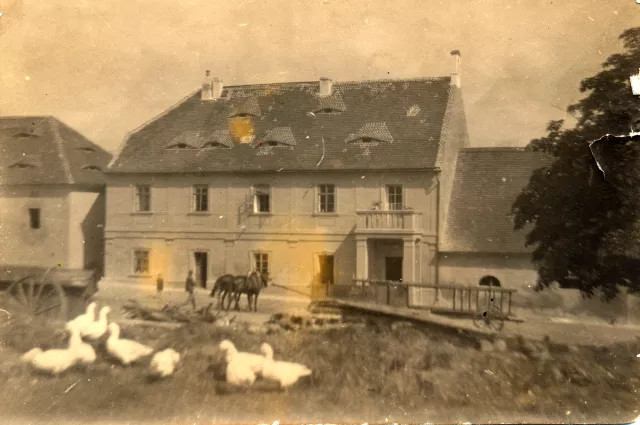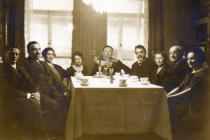Doubravice estate, where relatives of Helena Kovanicova lived
This is a picture of the Vohryzek family home on the estate in Doubravice, near Teplice, which was owned by my father's siblings and their families, the Vohryzeks and the Munks. My father had two siblings, Bedriska and Josef, who also married siblings, so everyone was related to everyone.
Our relatives from Doubravice were quite rich by the standards of those days, the estate all told was worth about a million crowns back then. Our relatives didn't own only the estate, but also large fields all around, where they grew wheat, rye, oats, beets and other agricultural crops. They had draught and riding horses and lots of farm animals. The farmyard included a hayloft, barn, pigsty, blacksmith's shop, dairy and also a fruit orchard that used to be called a 'plummery.' Uncle Vohryzek raised pigs. We didn't have any problems with that, because we were fully assimilated Jews.
Vilem and Bedriska Vohryzek lived right on the estate, which was surrounded by walls and locked gates. At night a night watchman with a German shepherd used to walk around it. The dog was a female, named Asina, and was terribly vicious. The farmyard included a hayloft, barn, pigsty, blacksmith's shop, dairy and other buildings. Outside of the farmyard stood a single-story villa where Josef and Marta Munk lived. Their villa was surrounded by a tiny yard, and Asina was tied up in the back all day, because she was allowed to run free only at night. The entire estate stood isolated, off in the middle of fields, only one road, which led to Trnovy, passed near the Munks' house.
We used to go visit our relatives in Doubravice often, mainly at Christmas and in the summer. Aunt Bedriska was an excellent homemaker. She was a superb cook. Whenever we were there for Christmas, Auntie would make loads of Christmas cookies. Often in the summer she'd prepare a young roast goose, which I especially liked. My aunt had attended dairy school in Varnsdorf or someplace there near the border. Because Aunt Bedriska used to spend the entire morning on her feet, in the afternoon she liked to sit down in her favorite leather armchair and devoted herself to handiwork, she'd crochet these strips of short columns, from which she then created various ornaments and sewed them onto tulle. She was skilful, but maybe it was also because back then girls were brought up to do handicrafts, they embroidered monograms onto their trousseaus and so on.
On the left of the Vohryzeks' house in the photo there's a passage between the houses that led into the garden. That garden wasn't overly taken care of, but had a small pool where we used to play as children. Later the Vohryzeks had the houses connected and built another room there, where the Vohryzeks' older daughter Hana lived. Her parents bought and furnished it with furniture and a Persian rug.
During World War II the German company Zeiss built a factory on a field by Doubravice.
































